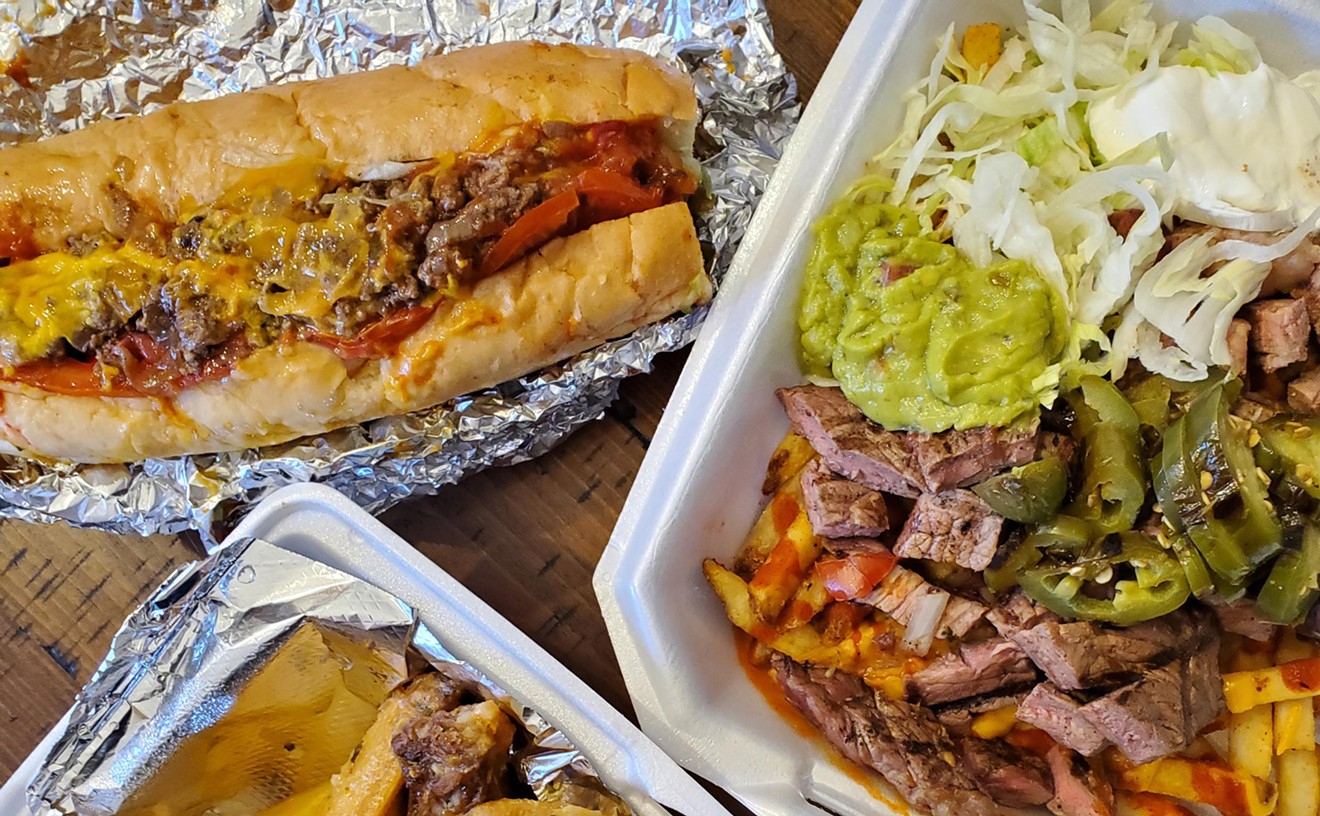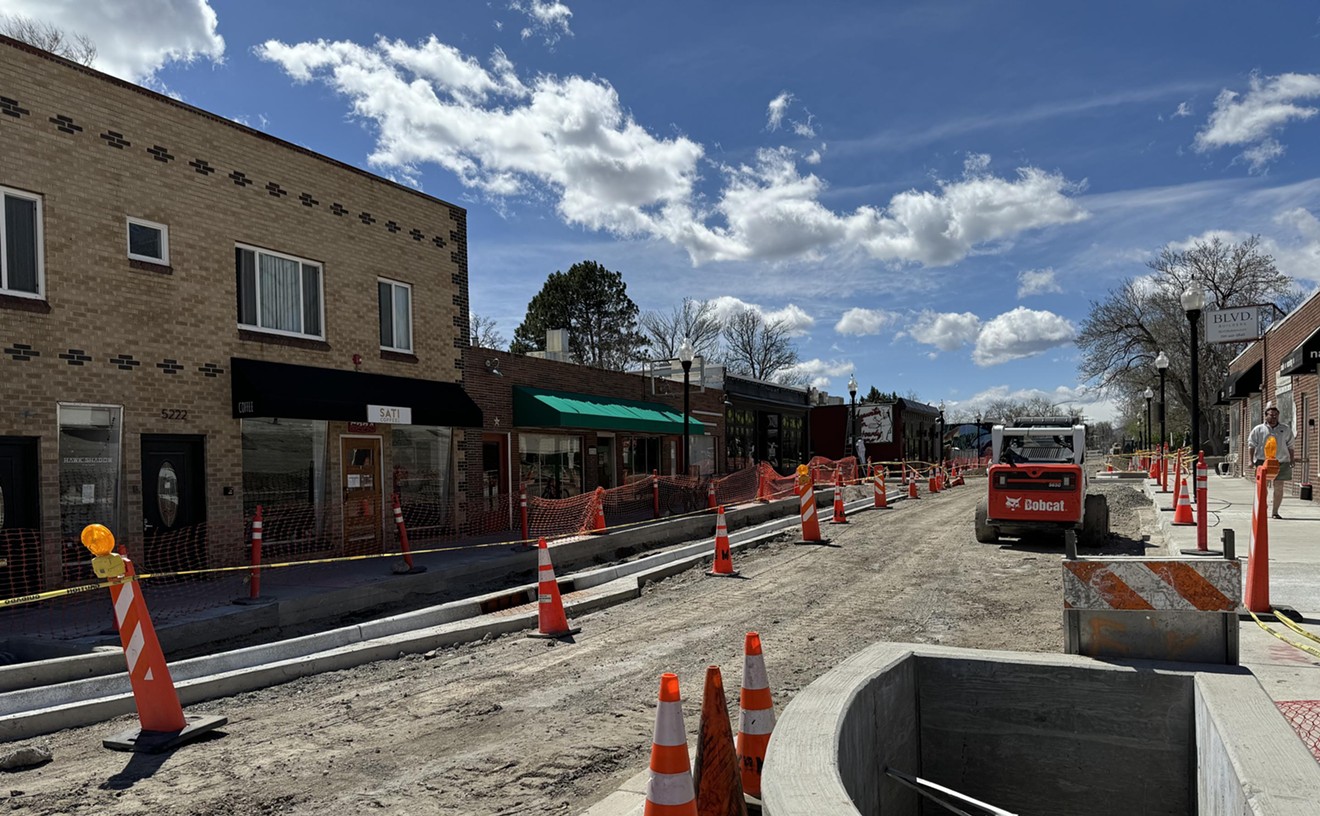It's not quite spring, but there's hope: Ramps and morels are on the menu. If the weather wasn't so cold and rainy, the waiter could open the glass garage door that separates our table from the patio. Soon, he says. Beyond the patio and the parking lot, everything's dark — the way it would be in the unlikely event that we were ordering gnocchi at a gas station in Swink or Hugo on the eastern plains.
Fuel Cafe, though not exactly a gas station, also has automotive roots. Part of the TAXI complex, it occupies a building where Yellow Cabs were once dispatched to downtown, less than two miles to the south, and points beyond. TAXI is turning into a compound of loft condos and office space for creative types — including Mickey Zeppelin, the developer, and his son, Kyle — as well as a gym or two, a coffee trailer and shops for tradespeople who build the actual things that go along with the ideas. Zeppelin and his architects are adding new TAXI buildings to the old at a speed dictated by the economy.
I always loved this part of Denver, and it's about time that humans came here — not just to work, but to live and eat. All the same, I'm glad that these urban pioneers didn't mess with the ambience, happy that Ready Mixed Concrete is unchanged to the east, that the banks of the South Platte just across the street remain undeveloped, weedy and lush. We're on the very border of Globeville, which continues to hold its own as a dependably exotic place.
Dinner will be served in a building that was once full of cars. I like cars, and many clues to the space's automotive origins have been left in place. Since I'll be looking around a lot, I hand my notebook to my sister Marina, who has food credibility, having cooked seriously since she was three, married a chef and burned through countless issues of Cook's Illustrated. Also, many years ago, she gave me a gas-station squeegee for my birthday. It meant a lot at the time and still does, I now discover, surrounded as I am by industrial/residential romance.
Back in the day, cabs would have lined up not far from this table. I remember a driver who used to recite existential poetry over the radio to his fellow cabbies, most of whom were surprisingly tolerant of Allen Ginsberg.
While I poke about the place, Marina writes this in my notebook: Despite the fact that the building is essentially a cinderblock cube, it has a good energy. It feels like a little, inviting secret, but not an "only-in-the-know" place. Though we are in the know, so what do we know?
Fuel is undeniably hip, at least in the classic way: hard edges and concrete floors, plain white plates, plain black T-shirts, good-looking people — many quite young — and a menu driven by a personality. To give you an idea of that personality, chef Bob Blair prefers to be called a cook, which is so modestly unhip as to be sort of charming. Fuel is his place and he cooks what he wants: Mediterranean-inspired dinners, from small plates to bigger, meatier entrees. He also cooks where he wants, though when he started Fuel over two years ago, he says, "I was a little nervous. It didn't make sense, at first, to put a restaurant in the middle of nowhere."
But the middle of nowhere proved sustainable, not that I'm surprised. Right now, I like the middle of nowhere enough to cook up a daydream in which I live across the parking lot in a 600-square-foot loft, grow spring greens in a community garden and force any itinerant train-hoppers to lend a hand. I appreciate that TAXI attracts creative people, but the real draw, for me, is its un-loftiness. There's no Greenwich Village pressing in; no prefab new-urbanism "Town Center." Everyone who lives here — or eats here — is on the frontier. Not in the Davy Crockett way, but in the way kids go nuts at the prospect of building a fort, even if they only go as far away as under the dining room table. That kind of frontier. If you lived here, your mother might be writing you a plaintive letter: Oh, honey, I always pictured you in that nice home down the block, the one with the walkout basement. With the Anderson replacement windows and all those good schools.
My own mother wouldn't have bothered. She knew my mind was warped early on by custody visits with my father, who lived for many years in a Long Island boatyard. A boatyard is not a yacht club. Three generations of Yugoslavian boat-builders worked there, some making beautiful, seemingly hand-carved wooden dories, others swearing at engines and drinking beer. There was no running water, other than what came from a hose on the dock, and nothing traditional to play with. We were always wandering from one giant, dusty shed into another, thinking of all the possibilities.
Ever since, I've fantasized about living in airplane hangars, abandoned Piggly Wigglys, freight cars, wine casks — or, hey, what about the Butcher Block Cafe #4? It's four blocks from Fuel, if that. If they'd quit serving eggs and rent me the place, I'd be an excellent tenant. I wouldn't require track lighting, granite countertops, closets or any of that fluff. Hell, I wouldn't even need interior walls. No need to get rid of that grease trap, either, not when it could be reborn as...a wood-fired pizza oven? World's smallest chapel? Sauna-ette? Really, if this isn't an itty-bitty Zeppelin project in the making, what is? Plus, who needs a satellite Whole Foods when you're this close to Do-it-ur-self Plumbing and Heating, with its yard full of orderly clawfoot bathtubs? It's the best place on earth to buy a large pink toilet someone wishes she still had.
Mickey Zeppelin appears to be sitting not two tables away, with a group of friends and his partner, Susan Wick, of City Spirit fame. (That legendary LoDo spot lives on in pieces of a mosaic mural at Fuel.) I hear she lives in an old brothel by the railroad tracks. Lucky, lucky, lucky. But enough petty jealousy. It's time to eat.
Our first small plate arrives: fried baby artichokes ($9) with harissa aioli. The concept is French, with a little Morocco thrown in; down-to-earth in a continental way. Then comes a pile of the Italian crepes known as crespelle ($10), fused with ricotta and aged provolone, drizzled with herbs and roasted tomato. Unaccountably, both Marina and I think of eating this dish while watching a really good football game on a very big TV, and every time I grab another crispy little artichoke, I think of diner food. At a five-star diner. In spring.
When I run this by Blair a few days later, he politely rejects it. "I do world cuisine," he says. "Solid, traditional Mediterranean classics. Not over-thought and over-complicated. Not reinventing, just revisiting. We did this appetizer of radicchio leaves sandwiched around smoked mozzarella and a slice of prosciutto, pan-roasted and fried; the filling oozes out the sides and gets crusty.... Everyone asked me how I thought of it, but it's just a simple family-style restaurant dish in Italy."
Point taken, especially by Marina, who recently spent $500 on a twenty-course meal at Moto in Chicago. She and Ryan ate goat-cheese snow — "essentially goat cheese blown through a snow machine," she says — and a dessert consisting of orange peel smoked by a laser and dunked into pinot noir. "The whole thing was spectacular," she recalls, "and we picked every dish apart in awe. But we started feeling chemically weird by course seventeen or so."
In short, it was exhausting.
Sometimes foodies need a break from dissecting every gourmet meal, she writes. You get the feeling that Bob is just doing what he likes, making some good food for good friends.
Maybe, but my friends have yet to serve me anything as inventive as Blair's gnocchi with ramps ($14). Native Americans depended on ramps to cure such wintertime vitamin-deficiency ailments as scurvy. I can feel these particular ones entering my bloodstream and turning me carnivorous. I attack a New York strip ($26) served with bourbon-ramp butter, pecan potatoes and arugula. The steak is a perfect medium rare, though our server never asked if that's how we wanted it, and while I usually think a good steak is best left alone, the morel-booze flavors change my mind this time.
The main thing, though, is the side — the pecan potatoes.
The potato stuff, Marina scribbles, that's where the genius is. Every other bite is a little different — a little toast, a little peppery green, some warm, buttery love. Like wearing fuzzy-footed PJs.
Hmmm. Dr. Denton's. It could get to that point. After I lived here for a while, no one would care what I wore to Fuel. I'd be a regular. If I didn't live here, I could live in an antique office suite in the old Livestock Exchange Building only half a mile away. And what was that big pink warehouse by the railroad tracks? Decades ago, for about a month, it was an unofficial nightclub known as the Stockyards; I played under-the-table gigs there with an under-the-radar band. Whatever the actual logistics, my barely-suitable-for-human-habitation-building fantasy always involves regular meals at a restaurant designed by me — a dreamy combination of bar, oyster shack, taco trailer, Morton's of Chicago and WaterCourse Foods. In the boatyard, my dad bought lobsters off the boat, boiled them in a stainless steel pail and served them with no sides at all, unless you count vodka, and I was too young for that. The boatyard also introduced me to stacks of ripe tomatoes with basil and the cheese known to Long Island eye-talians as "mozz."
Simple, indigenous cuisine.
Blair stops by to ask about dinner, but also to bus the table. "I'm a cook, I'm a dishwasher, I'm a server," he shrugs. "Whatever has to be done."
Unpretentious, Marina writes. Unapologetic is another good word.
Dessert is a tarte tatin ($7) made not with apples, but with rhubarb — a tweak almost as original as the goat cheese ice cream, which is velvety, not too sweet and kind of inspiring.
I'm thinking there's a lot of open land around here. TAXI could run its own herd of goats. Fuel could make its own line of goat-derived products. I could use the goat-derived manure in a massive compost operation designed by some of the creative people I keep hearing about. It's probably a ridiculous idea, but when I live here, they'll have to humor me. The thing is, I'll bet they know how to do that, too.










